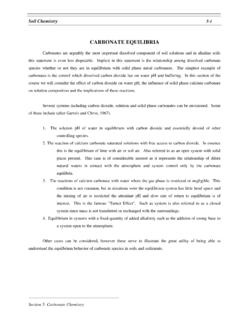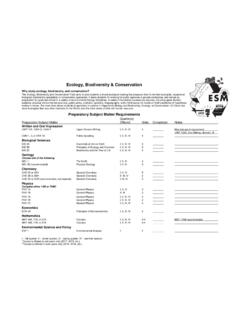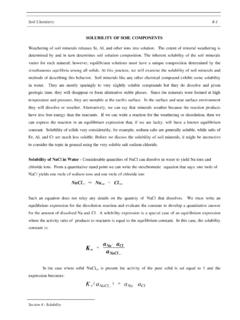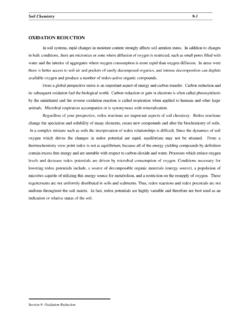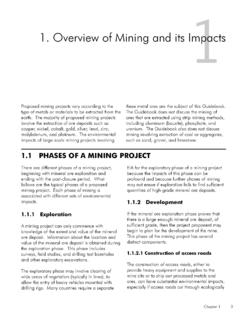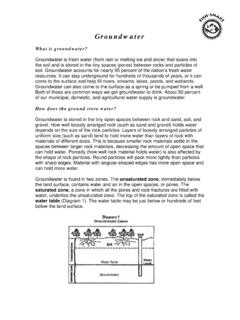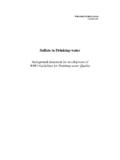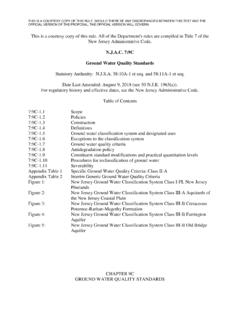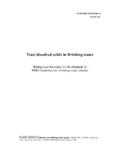Transcription of CHAPTER 1. SOIL PHYSICAL PROPERTIES
1 SSC107-Fall 2000 CHAPTER 1, Page - 1 - CHAPTER 1. SOIL PHYSICAL PROPERTIESC ontents: Soil physics Soil texture Soil surface area Soil structure Volume and mass relationships Water content measurements UnitsSOIL PHYSICS: THE STUDY OF THE STATE AND TRANSPORT OF ALL FORM OFMATTER AND ENERGY IN SOILSJ Why study soil physics ???ATMOSPHEREROOTZONESOIL SURFACEVADOSE ZONE CROPSSTREAMGROUNDWATERSOILS: SOURCE OF NUTRIENTS AND WATER FOR CROP AND PLANT GROWTH CONDUIT BETWEEN SOIL SURFACE AND groundwater ACT AS FILTER AND A BUFFERSSC107-Fall 2000 CHAPTER 1, Page - 2 -Soils are extremely complex, hence we often simplify to study and understand soil physicalprinciples, , soil particles are spherical soil pores are composed of capillary tubes soil is homogeneoussoil particlessoil gassoil waterSOIL SOLID PHASE IS CHARACTERIZED BY SOIL TEXTURE - SIZE DISTRIBUTION OF SOIL PARTICLES CHEMICAL AND MINERALOGICAL PROPERTIES SHAPE AND SURFACE AREA OF SOIL PARTICLES SOIL STRUCTURE - ARRANGEMENT OF INDIVIDUAL SOIL PARTICLESSoil texture.
2 SSC107-Fall 2000 CHAPTER 1, Page - 3 -Has a large influence on water holding capacity, water conducting ability and chemicalsoil propertiesSoil Texture Classification:Soil separateequivalent diameter size (mm)gravel> 2 - 2 mmvery coarse1 - 2 - 1 - - mmvery - - mmClay< mm (< 2 micrometer)J How to measure soil particle size ???1. Mechanical sieving, if size > mm2. Sedimentation - Stokes law, if size < mmHydrometer methodPipette methodSoil is dispersed, and mixed with water (soil suspension);Settling velocity of individual particles depends on particle diameter;Forces acting on soil particle are gravitation, buoyancy and drag forces,and all depend on particle size;The larger particles settle first Stokes lawSince soils are a mixture of different size particles, soil s are classified using the so-calledsoil textural 2000 CHAPTER 1, Page - 4 - Soil Textural TriangleSoil mineralogical composition: Primary minerals: present in original rock from which soil is formed.
3 These occurpredominantly in sand and silt fractions, and are weathering resistant (quartz,feldspars); Secondary minerals: formed by decomposition of primary minerals, and theirsubsequent weathering and recomposition into new ones (clay minerals). Humus or organic matter (decomposed organic materials)Mineral type has large influence on soil behavior: Ion exchange, related to cation exchange capacity Hydration and swelling; dehydration and shrinking Flocculation and dispersion Preferential flow, as through soil cracks Barrier to flow, as by swelling clays Chemical adsorption of contaminants and nutrients, both in liquid and gas phaseSSC107-Fall 2000 CHAPTER 1, Page - 5 -Soil s specific surface area (s, m2/g):Depends on shape of soil example, if spherical (r = radius and = density)Surface area (a) = 4 r2 Mass (m) = V = [4 r3/3]Thus, specific surface area (s=a/m): s = 3/ r (inversely proportional to radius)J How to approximate surface area of a clay particle ?
4 ??Surface area of soil affects its PHYSICAL and chemical PROPERTIES and is largelydetermined by amount of clay present in soil:Specific surface area of soil particlesEffectiveAreaSpecific Surface AreaParticleDiameter (cm)Mass (g)(cm2)(cm2 g-1)Gravel2 x x x x x x x x x x 104 Claya2 x x x x 106aThickness = 10-7 cmJ Compute the surface area of 1 gram of clay in m2 .SSC107-Fall 2000 CHAPTER 1, Page - 6 - Surface Area Clay SiltSandParticle sizeJ Which PHYSICAL and chemical PROPERTIES are largely affected by surface area???Soil Structure:The arrangement and organization of soil particles in the soil, and the tendency ofindividual soil particles to bind together in aggregates;Aggregation creates intra-aggregrate and inter-aggregate pore space, thereby changing flowpaths for water, gases, solutes and pollutants;Effects on plant growth operates through:1.
5 Aeration2. Soil compaction3. Water relations4. Soil temperatureStructure development is influenced by:SSC107-Fall 2000 CHAPTER 1, Page - 7 - Amount and type of clay, as well as the exchangeable ions on the clay (also water actsas bridge between clay particles) Amount and type of organic matter, since it provides food for soil fungi and bacteriaand their secretion of cementing agents (polysaccharides) Presence of iron and aluminum oxides (cementing agents). Binding between organic and inorganic compounds (aluminium oxides, cations, clays) Vegetation: produces OM, roots act as holding soil together, and protects soil surface cations+Cation-dipole - ++- - - negatively-chargedinteractions between +clay particle clay particles - -+ -+ + - + - - +++ - - -TOTAL CHARGE MUST BALANCEClay - quartz - OM interactions OMClayTypes of soil structure:1.
6 Single-grained (windblown particles such as silt; sand) - highly erodable2. Massive (heavy clays)QuartzQuartzSSC107-Fall 2000 CHAPTER 1, Page - 8 -3. Aggregated (ideal soil structure)Characterization of soil structure: (mostly qualitative, since is a function of time)1. Size- Particles (particle size distribution)- Aggregates (dry-sieving; water stability test by wet-sieving)- Porosity2. Morphological- Blocky- Plately- Prismatic3. PHYSICAL - Pore size distribution - water desorption method fraction of little structuretotal pore space much structure diameter (micrometer)SSC107-Fall 2000 CHAPTER 1, Page - 9 - - Water permeability (ratio of permeability to air and water) Air permeability/ water permeability soil Treated with soil conditioner 0 Exchangeable sodium/cation exchange capacitySSC107-Fall 2000 CHAPTER 1, Page - 10 - - Stability upon wetting (wet sieving)100 loam with sodPortion ofloaminitial samplecultivatedremaining onsieve (%)
7 Silt loam, cultivated 0510 Sieving Time (minutes)- Ability to reform upon drying- Hardness- Mechanical impedance (cone-penetrometer tests)- Crusting (infiltration measurements)- Compaction (bulk density measurements)Soil structure deterioration by:1. Tillage and cultivation2. Decrease in organic matter3. Silt and salt in irrigation waterSSC107-Fall 2000 CHAPTER 1, Page - 11 -The following graph from Greacen (1958), shows the influence of exposure time tomicrobial decomposition of OM on soil structure (percentage aggregation):0 Percentage aggregation (%) 100 virgin soilDepthfrom 10-year pasturesoil surface(inches) 3 3-year pasturecontinuous cultivation 6 Tendency of soil aggregation is also largely influenced by climate (West to East in US):50 PercentAggregation Aridisols Mollisols Spodosols 0 Increasing rainfallTemperature also affects aggregration.
8 SSC107-Fall 2000 CHAPTER 1, Page - 12 -Stable aggregation is caused by OM (arid soils) or oxides (humid soils): GeorgiaLaterization (Oxisols) 75 SaskatchewanPercent humidAggregation semi-aridQuebec - Podsolization (Spodosols)Texas0 Increasing mean annual temperatureStructural stability or resistance of soil to disintegrative forces (rain, cultivation, soilswelling), depends on type of organic matter and its changing from low to high C/N as aresult of microbial breakdown of OM: green manureStructuralstabilityburied straw highly decomposed manureweeksmonthsyearsTime since incorporationSSC107-Fall 2000 CHAPTER 1, Page - 13 -Soil structure detoriation causes soil compaction, reduced gaseous exchange betweenatmosphere and soil (aeration), and reduction in infiltration: INFILTRATIONA iken clay loam (Fe)Infiltrationrate(cm/hr)Palouse silt loamHouston black clay 0 Time (hours)AERATIONAND COMPACTION 70 Bulk Density (BD) = BD = ofroot penetration(mm)BD = 35BD = = Oxygen (percent)SSC107-Fall 2000 CHAPTER 1, Page - 14 -Soil Compaction.
9 N Compression of an unsaturated soil, resulting in reduction of fractional air volumen Natural and human-induced compaction:n Surface crustsn Hardpansn Clay pansn Carbonatesn Tillage pansn Trampling by animalsn Machineryn Compaction measurementsn Bulk densityn Penetrometer (indirect, and measures soil strength)Gauge and hammer-type penetrometers: Dial gaugeHammerSOILSSC107-Fall 2000 CHAPTER 1, Page - 15 - dry soil Soil Strength (Force/area)wet soilBulk DensityVolume and Mass Relationships in Soils (comprising of solid (s), liquid (l) or water (w)and gas (g) phase: Volume relationsMass Relations Vg mg Vpores VlmlV m VsmsV = = Vs + Vl + Vgandm = ms +ml + mgVpores = Vl + Vg and Porosity ( )= Vpores / VV = bulk volume of soil (total soil volume)Porosity in soils varies between (sands, silts) to (clays) to (peat), and islargely determined by the soil bulk density:airwatersolidsSSC107-Fall 2000 CHAPTER 1, Page - 16 - b = ms/V ,and includes dry mass only (Dry bulk density), its units are in g/cm3 (or Mg/m3 ) andvaries between <1 (peat) to (clays) to g/cm3 (sands)J What is density of organic matter ?)
10 Sometimes, we use wet bulk density, and it is defined as wb = (ml + ms)/VMoreover, we define density of each of the specific phases, or m = ms/Vs varies between for most mineral soils (mineral density) l = ml/Vl is about for water and assumed constant (water density) g = mg/Vg approximately zero, relative to other phases (gas density)Hence: wb = m/V = mg/V + ms/V + ml/V , hence wb = mg/Vg * Vg/V + ms/Vs * Vs/V+ ml/Vl * Vl/V , or wb = a g + (1- ) m + l = b + (cgs units)where a = Vg/V (volumetric gas content) and = Vl/V (volumetric water content)J Show that = 1 - b / m = (V Vs)/ V = 1 Vs/V = 1 (ms/ m) / (ms/ b ) = 1 b / mJ What are the units of , , and a ?SSC107-Fall 2000 CHAPTER 1, Page - 17 -Water content measures:1.
